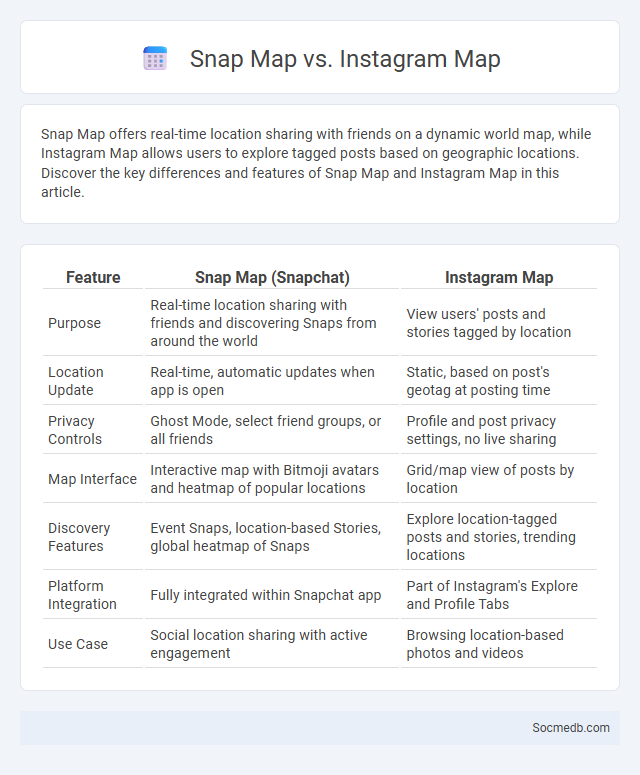
Photo illustration: Snap Map vs Instagram Map
Snap Map offers real-time location sharing with friends on a dynamic world map, while Instagram Map allows users to explore tagged posts based on geographic locations. Discover the key differences and features of Snap Map and Instagram Map in this article.
Table of Comparison
| Feature | Snap Map (Snapchat) | Instagram Map |
|---|---|---|
| Purpose | Real-time location sharing with friends and discovering Snaps from around the world | View users' posts and stories tagged by location |
| Location Update | Real-time, automatic updates when app is open | Static, based on post's geotag at posting time |
| Privacy Controls | Ghost Mode, select friend groups, or all friends | Profile and post privacy settings, no live sharing |
| Map Interface | Interactive map with Bitmoji avatars and heatmap of popular locations | Grid/map view of posts by location |
| Discovery Features | Event Snaps, location-based Stories, global heatmap of Snaps | Explore location-tagged posts and stories, trending locations |
| Platform Integration | Fully integrated within Snapchat app | Part of Instagram's Explore and Profile Tabs |
| Use Case | Social location sharing with active engagement | Browsing location-based photos and videos |
Snap Map vs Instagram Map: Overview
Snap Map offers real-time location sharing that emphasizes user privacy controls and spontaneous social interactions, allowing users to see friends' activities on an interactive geographical interface. Instagram Map centers on photo and video geotagging, enabling users to explore content based on locations, which enhances visual storytelling and local discovery features. Both platforms integrate location-based experiences but prioritize different user engagement methods: Snap Map focuses on live updates and presence, while Instagram Map highlights content exploration through spatial tagging.
Key Features Comparison
Social media platforms offer diverse key features such as content sharing, real-time interaction, and targeted advertising, with Facebook emphasizing community building, Instagram prioritizing visual storytelling, and Twitter excelling in concise news updates and trending topics. Advanced algorithms on TikTok drive personalized content discovery, while LinkedIn specializes in professional networking and career development tools. Privacy controls, multimedia integration, and user engagement metrics vary significantly, influencing user experience and platform preference.
User Interface and Design
Social media platforms prioritize intuitive user interface (UI) and visually appealing design to enhance user engagement and retention. Elements such as responsive layouts, clear navigation menus, and consistent iconography contribute to a seamless user experience (UX). Effective use of color schemes, typography, and whitespace not only improves readability but also reinforces brand identity across platforms like Instagram, Facebook, and Twitter.
Location Privacy Controls
Location privacy controls on social media platforms empower you to manage who can see your geographic information, helping protect your safety and personal data. By adjusting settings to limit location sharing or disabling geotagging features, you reduce the risk of unwanted tracking and data breaches. Regularly reviewing these controls ensures your digital footprint remains secure and aligned with your privacy preferences.
Real-Time Sharing Capabilities
Real-time sharing capabilities on social media platforms enable you to instantly broadcast updates, photos, and videos to a global audience, fostering immediate interaction and engagement. Features like live streaming, instant stories, and real-time commenting enhance connectivity and create dynamic conversations among users. These tools maximize your reach and allow for timely dissemination of information, crucial for personal branding, marketing, and community building.
Discoverability of Public Content
Social media platforms prioritize the discoverability of public content by utilizing advanced algorithms and indexing techniques to surface relevant posts to a wider audience. Your public content is ranked based on engagement metrics, keywords, and user interactions, ensuring greater visibility beyond your immediate network. Optimizing hashtags, captions, and consistent posting enhances the chance for your content to be discovered by new followers and communities.
Integration with Other Platform Features
Social media platforms offer seamless integration with various external features such as e-commerce tools, customer relationship management (CRM) systems, and content management platforms to enhance user engagement and streamline business operations. API connectivity allows real-time data sharing and automated workflows between social networks and third-party applications, boosting efficiency and personalized marketing strategies. These integrations enable multi-channel campaigns, unified analytics, and improved audience targeting, maximizing the potential of social media as a comprehensive digital marketing hub.
Audience Engagement Tools
Audience engagement tools on social media platforms enhance interaction by utilizing features like polls, live videos, and interactive stories to foster real-time communication. These tools leverage algorithms to boost content visibility and personalize user experiences, increasing retention and brand loyalty. Integrating analytics dashboards helps track engagement metrics, enabling more targeted and effective campaign strategies.
Safety Concerns and User Trust
Social media platforms face significant safety concerns, including data breaches, cyberbullying, and privacy violations that threaten user trust. Ensuring robust security measures, transparent data policies, and responsive content moderation enhances Your confidence in online interactions. Building a trusted environment encourages responsible behavior and long-term platform engagement.
Which Map is Best for You?
Choosing the best social media map depends on your specific goals, whether targeting audience engagement, content performance, or trend analysis. Platforms like Hootsuite Maps excel in visualizing global user interactions, while tools like Sprout Social provide detailed demographic insights and sentiment analysis. Prioritize maps that integrate real-time data with customizable filters to optimize your social media strategy effectively.
 socmedb.com
socmedb.com